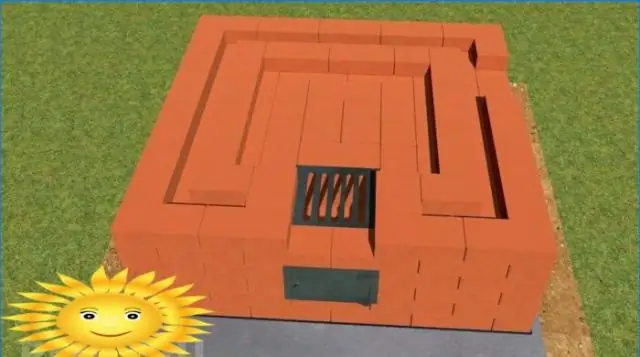
Table of contents:
- Author Bailey Albertson [email protected].
- Public 2023-12-17 12:53.
- Last modified 2025-01-23 12:41.
Diy chimney deflector

The design of the chimney assumes the presence of a deflector, which performs several important functions. The main task of the device is to provide good traction and therefore it is necessary to know the structure of the structure.
Content
-
1 Purpose of the deflector
1.1 Features of the device
-
2 Types of "caps"
- 2.1 The principle of operation of the structure
- 2.2 Drawings, dimensions and parameters
- 2.3 Materials and tools
- 2.4 Preparing for assembly
-
3 Making a deflector with your own hands
3.1 Operation and repair of the deflector
- 4 Video: making a weather vane for a chimney
Deflector purpose
The correct functioning of the chimney of the stove heating ensures good heating of the house. When the wind enters the chimney lumen from outside, the system malfunctions, that is, smoke and draft are significantly reduced. To prevent such an effect, a deflector is needed, which ensures the normal operation of the furnace heating system.

The deflector has a simple design
Efficient traction improves fuel burnout by up to 20%. This increases the efficiency of space heating. The deflector to achieve this goal has a simple design. The device includes the following elements:
- upper and lower cylinders;
- lower cylinder branch pipe;
- protective cap;
- brackets.
Some designs do not include an upper cylinder, which is optional. The deflector assumes the presence of a lower cylinder, a diffuser and a reverse and a straight hood. In this case, the lower cylinder is attached to the chimney, and a diffuser is needed to separate the air flow. A complex of simple elements improves the efficiency of the chimney by increasing the draft.
Features of the device
The deflector is practical to use, but it is important to consider its purpose. In regions with strong winds, the device is convenient, but in the absence of a constant movement of air masses or in a downwind, the design does not enhance traction, but only reduces this process. In this case, it is worth using deflectors with a built-in special mechanism, which includes an axle on bearings, a semi-cylindrical screen, a canvas and a cover. When the direction of the wind flow changes, the vane fabric turns, protecting the chimney from incorrect movement of air masses.

The deflector is convenient for stove heating
The deflector is an indispensable element of the flue system for stove heating. The device has other names: head, chimney, weather vane, as well as a cap and a fungus. In some cases, the deflector is called an umbrella or visor, but a protective device is always assumed to help increase traction. At the same time, a simple umbrella, visor or fungus differ from a functional deflector in that they provide only external protection for the chimney. A full-fledged device enhances traction, has protection from downstream wind, and prevents the penetration of precipitation into the pipe. Thus, the deflector performs a set of functions that provide effective heating of the house.
Types of "caps"
The main purpose of deflectors of any kind is the same, but the devices differ in design features. Therefore, they are divided into certain types:
- spherical deflector;
- Grigorovich's device;
- poppet version;
- TsAGI ventilation;
- H-shaped device.
These models are classic and effective in use. The “weather vane” or rotating deflector variants differ from them in design, but operate on the same principle as the usual ones. In any case, the device must be made of material resistant to high temperatures and climatic precipitation. Galvanized iron or copper is often the foundation of the structure. Products coated with enamel or polymer layer are among the newest options. When installing the element on the chimney, there is contact with hot air. Therefore, plastic products cannot be used. They are only optimal for ventilation ducts.

Ball-shaped devices are beautiful and comfortable
When choosing a product, one should take into account the quality and reliability of fastening all elements. Swivel parts must rotate gently and gently, and the parameters of the lower cylinder must correspond to the dimensions of the chimney. It should be borne in mind that the deflector is used only on round pipes. Brick square chimneys require the installation of an additional adapter.
The principle of operation of the structure
The external fixture for the chimney can have any shape, but the principle of operation is always the same. Air currents, moving along the roof of the building, hit the body of the deflector and bend around it. As a result, a discharged zone is created. According to Bernoulli's law of aerodynamics, there are discharged air masses in this area, which do not impede thrust. The smoke output and the quality of fuel combustion are enhanced, which makes the deflector effective.

The disc deflector is practical
Any version of the classic cap assumes the presence of a lower cylinder. This part is attached to the chimney. From above, the product is supplemented with an "umbrella", that is, a cover that protects the chimney from precipitation. Parts of the structure ensure high-quality and correct operation of the deflector.

The design of a simple deflector is laconic
All structural elements of the chimney fixture must be securely fastened together. It is especially important to determine the parameters of the product, because its performance depends on it.
Drawings, dimensions and parameters
When creating a deflector with your own hands, you need to determine the dimensions and make a drawing. The parameters of the product are selected based on the inner diameter of the finished chimney pipe. According to the available data, it is necessary to select the height (H) of the product and the width of the diffuser (D).

Deflector dimensions depend on the inner diameter of the chimney
If the required pipe parameter is absent in the table, you should use such ratios as for the product height 1.6-1.7 d, and for the diffuser width 1.2-1.3 d, the hood width 1.7-19 d. In this case, d is the inner diameter of the existing chimney pipe. The obtained data serve as the basis for calculating the amount of material. All indicators should be indicated on a drawing, which assumes a detailed image of structural details.

A rough drawing might be the simplest
A correct drawing or diagram makes it easier to create a chimney fixture. The figure shows the dimensions and fastenings of all elements.
Materials and tools
You can make your own device for improving the chimney draft using simple tools that must be accurate, sharp and of high quality. Without taking these requirements into account, it is impossible to create a reliable and durable product. The set of devices and tools includes:
- tape measure, ruler;
- scissors for cutting metal;
- mallet, self-tapping screws with a 15 mm press washer;
- drill with a set of drills.
The construction is based on sheet metal, the thickness of which should be 0.3 - 0.5 mm. For this, materials such as galvanized metal, aluminum, stainless steel are optimal. It is easy to make rigid fixings using thicker metal strips than the base sheets. And also for work, you can use a riveter, replacing the screws with it.
Preparing for assembly
The sheet metal must be cut into pieces with scissors, taking into account the required dimensions of the parts in unfolded form. To do this, it is best to make templates on thick cardboard, and then transfer the shape to metal. In this case, a marker is used that provides a clear trace.

Templates for all parts make work easier
Elements for rigid fixation of all structural components must be cut to the required dimensions. With the help of such parts, the lower cylinder, the protective cone and the upper cylinder are held together. Rigid parts must be bent to an optimal shape that allows the cylinders and the cone to be connected later.
Making a deflector with your own hands
The complex of works on the manufacture of a protective device for a chimney includes simple steps. In this case, it is worth following the drawing, taking into account the assembly diagram and carefully connecting all the parts. The main assembly steps are as follows:
-
It is necessary to fold the housing, which is the base of the diffuser. The edges are drilled and fastened with rivets. Next, you also need to rivet the lower and upper cylinders, but the diameter of the upper one is greater than the parameter of the lower one. The outer one is used to fasten the elements together. At the edge of the upper element, you need to cut and bend 6 strips-legs;

Locking cone Fasteners are also needed for the cone
-
In the lower cylinder, "legs" are installed for attaching the upper element. You can fix the strips with rivets. All elements are assembled from the bottom cylinder to the cone;

Assembling the structure Rivets allow you to securely fasten the elements
-
Installation of the structure involves installation on the chimney pipe. To do this, you can remove the top of the pipe and mount all the parts in a more convenient place, and then install on the roof.

Ready product The assembly is carried out sequentially
The assembly of the deflector involves sequential fastening of the elements, taking into account the location of the rigid strips. For fixing, rivets or self-tapping screws with a press washer are optimal, but it is important to carefully connect the parts.
Deflector operation and repair
The product is installed at the very top of the chimney, carefully securing the structure. During operation, the device does not require special actions, because a properly assembled structure is effective and helps to increase traction. This requires regular cleaning of the device, which involves removing the structure from the pipe. After that, you need to remove all dirt with a brush, and also cover the metal with an anti-corrosion compound or special paint.

The deflector should be kept neat
If the structure is damaged and has dents or cracks, then all the cracks should be soldered, the surface should be straightened. Very long-term operation may require replacement of the product, since climatic precipitation and high air temperature from the chimney significantly affect the deflector.
Video: making a weather vane for a chimney
The device for protecting the chimney and increasing the draft is practical and necessary for the efficient operation of the heating system. The correct design and correct dimensions of the product are the key to its quality work.
Recommended:
How To Make A Brick Chimney With Your Own Hands: Diagram, Device, Etc

Brick chimneys - design features, advantages and disadvantages, calculation of parameters. Step-by-step instructions for making it yourself
How To Make A Chimney In A Bath With Your Own Hands: Scheme, Device And Calculation, Output Through The Ceiling, Insulation, Step-by-step Guide With Photos And Videos

The chimney in the bath: what is it, why is it needed, what kind of structure it has and how it is made by hand
How To Make A Chimney For A Potbelly Stove With Your Own Hands: Diagram, Calculation (including Diameter), Photo, Video, Etc

A step-by-step guide for the manufacture and installation of a chimney with your own hands for a stove. The choice of material and rules of operation
How To Make A Weather Vane With A Propeller With Your Own Hands, Including Drawings And Step-by-step Instructions

Features of a weather vane with a propeller. What material to choose. How to make a weather vane with your own hands: step by step instructions. Photo and video
How To Make A Weather Vane With Your Own Hands, Including Sketches, Drawings And Step-by-step Instructions

How and from what materials a weather vane can be made. Description and design features of windsocks, method of their manufacture and installation rules on the roof
